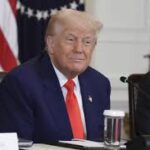U.S. President Donald Trump has threatened to impose an additional 50% tariff on Chinese imports if Beijing fails to revoke its newly announced 34% counter-tariff by Tuesday.
The ultimatum follows Trump’s recent rollout of sweeping import duties under his “Liberation Day” tariff package, which includes a 34% levy on Chinese goods and a minimum 10% tariff on imports from nearly all U.S. trading partners.
Posting on his social media platform, Truth Social, on Monday, Trump said all talks with China regarding tariff negotiations would be terminated if Beijing did not back down.
If enacted, the new tariff would raise the total duties on some Chinese goods to 104%, factoring in previous tariffs of 20% in March and the latest 34% hike.
In response, Chinese embassy spokesperson Liu Pengyu accused the U.S. of “economic bullying,” calling the move unilateral, protectionist, and a threat to international trade norms. The embassy criticized the U.S. for prioritizing national interests under the guise of reciprocity.
Despite growing global concerns, Trump signaled he was not open to pausing the tariffs for negotiations. “There are going to be fair deals,” he said, emphasizing the need to address the U.S.’s economic imbalance. “We have $36 trillion debt for a reason. It’s now America first.”
The escalating trade dispute rattled global markets. U.S. stocks plunged on Monday, while the FTSE 100 and other European indexes closed more than 4% lower. Hong Kong’s Hang Seng index suffered a 13% drop—the sharpest single-day fall since 1997—before partially rebounding on Tuesday.
The U.S.-China trade relationship remains a critical component of the global economy. China’s key exports to the U.S. include electronics, furniture, toys, and vehicles, while American exports to China consist largely of oilseeds, aircraft, and pharmaceuticals.
With the Tuesday deadline approaching, the international community is closely watching Beijing’s next move.









